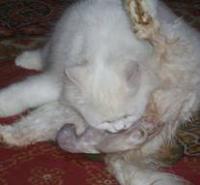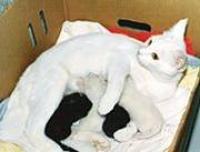Cat Reproduction
Cat reproduction is a fascinating topic. Did you know that just one in-tact (meaning 'unspayed') female cat breeding, assuming that her offspring remain in-tact as well, can be responsible for as many as 420,000 kittens over a period of seven years? It's true, and therefore quite obvious that cats are prolific breeders. This accounts for the huge number of wild cats and stray, homeless cats that overwhelm our shelters each year, many of whom are euthanized. Cat adoption can save many lives, but cats can produce kittens at a much higher rate. For this reason, neutering your pets is highly recommended. However, if you have a cat whom you are allowing to mate, it is important to know about feline reproduction.
While it is most common for female cat reproduction to begin between six and nine months, they can become pregnant as early as four months of age.
Male cats likewise will reach maturity and be capable of cat breeding before one year of age.
In seasonal climates, mating usually takes place during the warmer months, however, it can occur at any time.
The time in the female cat reproduction cycle when she is most likely to mate is called the oestrus cycle, commonly referred to as being "in heat". This period of time is usually four to seven days, but can last longer. Female cats let male cats know they are ready to mate with a certain type of cry during this time.
Feline reproduction is quite a unique process. Female cats are capable of induced ovulation. The female does not ovulate until the backward pointing spines on the male's penis stimulate the vagina. A single litter of kittens can have different fathers due to this phenomena. The process of mating is likewise noisy. The female's cries can be very disturbing if you don't know what they are.
If the female becomes pregnant, the pregnancy lasts a little over 2 months, most commonly around 66 days. Cats do not go through menopause which means they can get pregnant at any age, and can even be re-impregnated within just a couple days of delivering a litter.
Cat Breeding: Determining Pregnancy
The biggest challenge from a pet owner's standpoint is that there isn't a way to easily track cat reproduction successes or failures. After all, there are no clear and simple pregnancy tests you can just run to pick up at the drug store! However, the Witness Pregnancy Detection Kit for dogs can be used on cats to detect the hormone relaxin, a sign of pregnancy, after about 30 days. Most owners become suspicious of pregnancy during the first few weeks just from weight gain and an enlargement of the abdomen.
If you need absolute proof, the earliest way to get confirmation that your cat is pregnant is with an ultrasound, which can give an answer as early as the 15th day. The heartbeats of the kittens can be heard around the 20th day. The nipples become more prominent as time passes and by the 35th day should be pink and quite obviously enlarged, as well as your cat’s belly being significantly enlarged. Your veterinarian can first feel the actual kittens through the abdominal wall around the 20th day.
In terms of other symptoms that could help you determine that your cat is in fact pregnant; cats can have morning sickness. If this occurs, it usually lasts just a few days and most commonly occurs during the third or fourth week. Lethargy and loss of appetite may happen at that time also. If it continues beyond a few days, you should see a veterinarian right away.
Around this time, more than half way through the feline reproduction cycle, aka mom’s pregnancy, the kittens that your veterinarian felt can no longer be detected. The nipples continue to enlarge and a milky fluid may be expressed from them. Ultrasounds can diagnose pregnancy the earliest and show heartbeats, but x-rays are more reliable for predicting the number of kittens the queen is carrying (although they should be avoided during early pregnancy).
By day 49, the kittens can once again be felt through the abdominal wall. The abdomen is quite obvious with its enlargement and kittens can often be felt moving if you place your hand on the abdomen. This will be true up until day 66, when mom delivers.
Vet Visits During Pregnancy
The key to a healthy cat reproduction process is not all that different from what would be done for a pregnant woman: Access to good medical care. The first veterinary exam for the breeding cat should occur within two to three weeks of mating to check on her overall health and provide the best plan for her pregnancy to ensure her health and the health of her kittens. There are certain medications that are approved for use during the cat reproduction cycle or during pregnancy, but there are many that are not. For example, GI parasites should be treated but only with a safe deworming medication, which your vet can prescribe. There are also flea preventatives that are safe to use, but most are not. Some vaccinations can be given during cat reproduction or pregnancy, but “modified-live” versions should be avoided.
Assuming no concerning symptoms arise in the following weeks, like lethargy, vomiting, diarrhea, loss of appetite, or discharge from the vaginal region, another veterinarian exam should be performed approximately one week before the due date to see how mom is progressing. If there are any concerning symptoms during her pregnancy, though, a trip to the vet is warranted right away
Feline Reproduction: Labor and Delivery
Fortunately, problems during labor and delivery are extremely uncommon during the cat reproduction process. One to two days before the cat is going to give birth, you may notice mom roaming around, acting restless and strange. She is trying to decide where she wants to have her kittens.
When you see this happening, it is best to confine her to one room where you want her to deliver. It should be a quiet, warm room that can be darkened easily and is easy to clean.
If you notice your cat licking her belly and vagina frequently and she loses interest in food, she is about to go into labor. She may also breathe faster and cry loudly. When actual uterine contractions are taking place, she will lie primarily on her side and occasionally squat and press downward.
During labor, it is very important that you not interrupt the process. If you want to watch, watch from a cracked door and stay very quiet. Labor can actually be interrupted if the queen is disturbed.
Kittens can be born minutes apart to as much as an hour apart. The mother cat will attend to each kitten, as it is born, licking open the sac in which the kitten is contained so that it can breathe. If she doesn't, which is an extremely rare occurrence, you must free the kitten's mouth from the membrane. The placenta is still connected to each kitten and will come out following each birth. The mother will take care of chewing off the umbilical cord connecting the kitten to the placenta. In the rare event that she doesn't, you can tie the cord off with string or even dental floss and cut the cord, leaving about an inch on the kitten.
The mom will begin nursing each kitten as it is born. If she doesn't, gently place the kitten on a nipple. A temporary bloody or greenish discharge from the mom's vagina is normal, as is the mother cat eating the afterbirths. Feline reproduction can be as icky as it is beautiful!
Watching for Problems Throughout the Cat Reproduction Cycle
You should contact your veterinarian if the pregnant cat is pregnant longer than 66 days after the cat breeding, if she stops eating or is weak or lethargic, a kitten becomes lodged in the birth canal longer than ten minutes, or the mom has contractions for more than four hours without producing a kitten. You should also be concerned if more than five hours passes after a kitten is born and you are sure there is another kitten still ready to be born.
In addition, mom could be having problems if her temperature is too low or too high or there is an infected smelling discharge from her vagina. In rare cases, a placenta may not have been expulsed if you see fewer placentas than there are kittens. Also, keep in mind that it is not uncommon for the mom to develop a mammary gland infection, which will appear as a hard, hot, and painful gland.
If you notice any of these possible complications during pregnancy, labor, or delivery, a trip to the emergency veterinarian is in order as both mom and kittens’ lives might be at risk. If you notice strange symptoms again after a successful delivery, remember, mom can become pregnant again as soon as four weeks after delivering kittens!
Don't forget the tricky cycle of cat reproduction; if mom is a stray or lives outdoors, or there is a high likelihood she will get outdoors, she can be spayed as soon as the kittens can do without her for the better part of a day, which is usually around 4 weeks old. She can return to nursing them after a day off. Otherwise, if she is safe indoors and is not likely to mate again, it’s best to let the kittens be fully weaned before spaying her, which would generally be 6-8 weeks after they are born.
All articles are reviewed and maintained by whiskerDocs team of veterinary experts.





